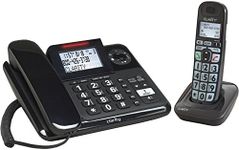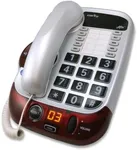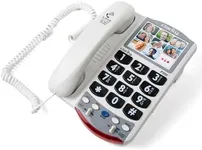Buying Guide for the Best Clarity Amplified Phones
When choosing a clarity-amplified phone, it's important to consider your specific needs and preferences. These phones are designed to help individuals with hearing impairments by amplifying sound and making conversations clearer. To find the best fit for you, you'll need to look at several key specifications and understand how they impact the phone's performance and usability. Here are the main specs to consider and how to navigate them.Amplification LevelAmplification level refers to how much the phone can increase the volume of the incoming sound. This is crucial for individuals with varying degrees of hearing loss. Amplification levels are usually measured in decibels (dB). Phones with lower amplification (20-30 dB) are suitable for mild hearing loss, while those with higher amplification (40-50 dB or more) are better for moderate to severe hearing loss. To pick the right one, consider the degree of hearing loss you or the intended user has.
Tone ControlTone control allows you to adjust the frequency of the sound, making it easier to hear certain pitches. This is important because hearing loss can affect different frequencies differently. Some phones offer basic tone control with a few settings, while others provide more advanced options with a wider range of adjustments. If you have trouble hearing high-pitched sounds, look for a phone with good high-frequency amplification. Conversely, if low-pitched sounds are harder to hear, ensure the phone can amplify those frequencies effectively.
Hearing Aid CompatibilityHearing aid compatibility (HAC) ensures that the phone works well with hearing aids, minimizing interference and providing a clearer sound. This is particularly important for users who rely on hearing aids. Phones with a high HAC rating (M3/T3 or M4/T4) are better suited for use with hearing aids. If you use a hearing aid, make sure to choose a phone with a high HAC rating to ensure the best possible experience.
Visual IndicatorsVisual indicators, such as flashing lights or screen notifications, alert you to incoming calls and messages. This is useful for individuals with both hearing and visual impairments. Some phones offer basic visual indicators, while others provide more advanced features like large, easy-to-read screens and customizable alerts. If you have difficulty hearing the phone ring, look for a model with strong visual indicators to ensure you don't miss important calls.
Ease of UseEase of use encompasses the overall design and user interface of the phone. This includes features like large, easy-to-press buttons, simple menus, and clear displays. For individuals with limited dexterity or vision, these features are particularly important. When choosing a phone, consider how easy it is to operate and whether it has features that accommodate your specific needs, such as speed dial buttons or voice-activated dialing.
Additional FeaturesAdditional features can enhance the usability and convenience of the phone. These might include speakerphone capabilities, answering machine functions, and Bluetooth connectivity. While not essential, these features can make the phone more versatile and user-friendly. Think about which additional features would be most beneficial for you and choose a phone that offers those options.






















